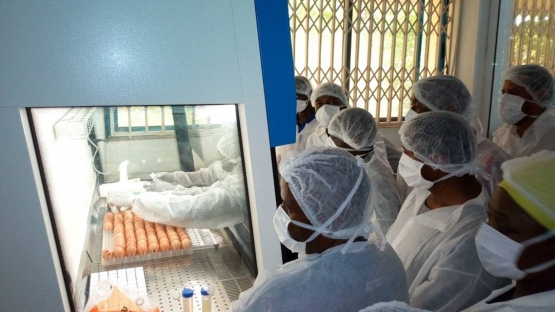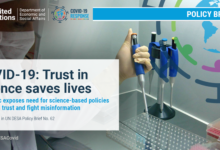
Hundreds of animal diseases can now be rapidly and accurately diagnosed by specialists at the Accra Veterinary Laboratory (AVL) in Ghana, helping to better protect farmers’ livestock and food security. The AVL enhanced facilities and team’s new skills, developed through support from the IAEA in cooperation with the Food and Agriculture Organization of the United Nations (FAO), are also an important new resource for many other countries in West Africa.
“It happens in some countries that veterinary services are poorly resourced, which means there is no capacity to effectively control diseases that hinder livestock production. This was also the case for the AVL,” said Joseph Awuni, Deputy Director and Head of the AVL Services in the Directorate of the Ministry of Food and Agriculture in Ghana. “Now, through IAEA support, the AVL can handle major animal disease outbreaks and is also considered a regional support laboratory in West Africa since we are now able to provide diagnostic support and training to neighbouring countries.”
Outbreaks test veterinary training
When in 2018 an outbreak of avian influenza was spotted in isolated areas around Boankra in Ghana’s Ashanti region, the AVL team’s new capabilities using molecular and nuclear-derived techniques were put to the test. This highly contagious virus can cause a high rate of organ damage and death in domesticated birds. So when suspected infections were reported, the team used their training and newly-installed equipment to quickly diagnose the disease and assist with early containment, preventing a major economic blow to the region’s poultry industry. 
In the same year the AVL team was fighting African Swine Fever that began spreading across Ghana and threatening the country’s pig industry. They immediately launched a depopulation effort on affected pig farms and put tight restrictions on animal movement to help contain the outbreak. In addition to collecting and testing tissue samples, they also began routinely using molecular diagnostics, which helped them rapidly and accurately diagnose 27 suspected outbreaks of the disease.
While the source of the swine fever outbreaks was uncertain, the team suspected it came from contact with wild pigs: the majority of Ghana’s pig population is raised in open forest areas, and often African Swine Fever spreads to domesticated pigs from wild boars. To get to the source of infection, the AVL team worked with experts from the Joint FAO/IAEA Division of Nuclear Techniques in Food and Agriculture to use a new method for detecting and identifying the virus in tissue samples from wild boars and the soft ticks that spread the virus through their bites.
The results showed no signs of the virus in wild pigs or the ticks in Ghana, which meant they were not the source of the outbreaks. The procedure the team developed for tracking the virus in wildlife has become a standard approach for detecting and controlling the African Swine Fever.
“Identifying the source of an infection is always important for taking preventative steps. In this case, the researchers rapidly concluded that wildlife was not infected by combining their knowledge of the terrain and farming practices with new approaches using nuclear-derived diagnostic techniques. So only trade of infected animals could have been the cause. This was an important finding because it meant the disease had not established itself in the local wildlife and wouldn’t be an ongoing problem for the local pig breeders,” said Hermann Unger, a technical officer in the Animal Production and Health Section of the Joint FAO/IAEA Division.
This procedure is one of several new approaches the AVL team has started using since they began the use of molecular diagnostics in 2006. The AVL is part of the FAO/IAEA Veterinary Laboratory Diagnostic (VETLAB) network, which includes laboratories from 64 countries, including 19 in Asia. In addition to training workshops, AVL’s team has received essential laboratory equipment and disease detection diagnostic kits through the IAEA technical cooperation programme and in cooperation with countries that participated in a recently completed project on the control of animal diseases to protect livestock production within the framework of the African Regional Cooperative Agreement for Research, Development and Training Related to Nuclear Science and Technology (AFRA). AFRA is an agreement between 42 African IAEA Member States to intensify their collaboration and expand the peaceful uses of nuclear science and technology to achieve national and regional sustainable development goals.
AVL’s enhanced capacities and the expertise developed in the accurate detection and rapid confirmation of diseases are now also benefiting other veterinary scientists in laboratories in West Africa. The team has already held two regional training courses for participants from over ten AFRA Member States and hosted trainees from Malawi, Sierra Leone and Uganda under IAEA fellowship programmes. They have also organized several month-long training courses for veterinary laboratory staff from several countries in West and North Africa.
Source: iaea.org







